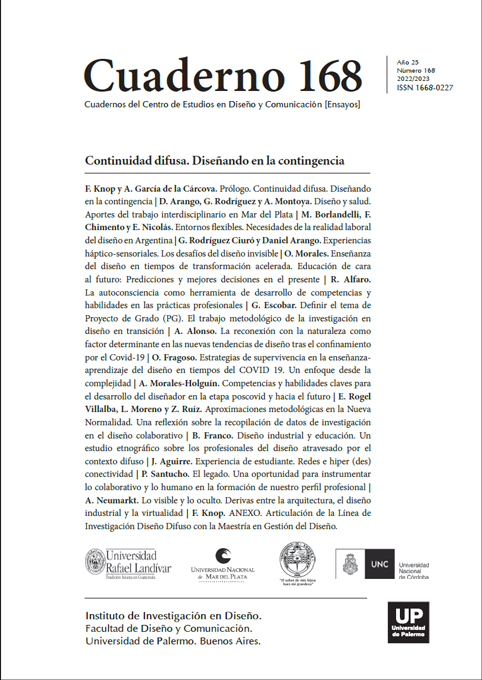La reconexión con la naturaleza como factor determinante en las nuevas tendencias de diseño tras el confinamiento por el Covid-19
Resumen
Tras el confinamiento obligatorio vivido por la extensión del virus SARSCoV-2 a nivel mundial, las necesidades espaciales y de equipamiento en el desarrollo del hábitat moderno para el ser humano, se han modificado según las percepciones individuales como consecuencia a las experiencias negativas y positivas que cada uno vivió durante el encierro en sus viviendas. Aspectos de la vida rutinaria tomaron un valor especial, y poco a poco se ha hecho más evidente y necesaria la reconexión con el entorno natural en los espacios habitables para mejorar el bienestar y salud mental de las personas.
Citas
Browning, W., Ryan, C. y Clancy, J. (2017). 14 Patterns of Biophilic Design. Nueva York: Terrapin Bright Green LLC.
Green, J. (04 de noviembre de 2020). Amid the COVID-19 Pandemic, Take Time to Reconnect with Nature. Archdaily. https://bit.ly/3kzEF07 Gobierno de Argentina. (03 de enero de 2022). Verano 2022: exitoso comienzo del año turístico en todo el país. Argentina.gob.ar. https://bit.ly/3MNWYee
Heerwagen, J. y Orians, J. (1986). Adaptations to windowlessness: A study of the use of visual décor in windowed in windowless offices. Environment and Behavior 18 (5): 623- 639. Doi: 10.1177/0013916586185003.
Hosteltur. (12 de febrero de 2021). Argentina: la pandemia se llevó un 77 % del receptivo y del emisivo. Hosteltur. https://bit.ly/3vyAXtN
Ikei, H., Song, C. y Miyazaki, Y. (2016). Physiological effects of Wood on humans: a review. Journal of Wood Science 63: 1-23. Doi: 10.1007/s10086-016-1597-9
Kaplan, R., Kaplan, S. y Ryan, R.L. (1998). With people in mind design and management of everyday nature. Places 13: 26-29.
Kellert, S. (2018). Nature by Design: The practice of Biophilic Design. Connecticut: Yale University Press.
Khozaei, F., Carbon, C.C., Hosseini Nia, M. y Kim, M. J. (2022). Preferences for Hotels with Biophilic Design Attributes in the Post-COVID-19 Era. Buildings 12 (427): 1-13. https://doi.org/10.3390/buildings12040427
Knight, C. (05 de octubre de 2020). Post-lockdown, city-dwellers treasure our urban green spaces more than ever. The Spinoff. https://bit.ly/3F80AoB
Leopold, A. (2019). Un año en Sand County. Traducido por A. González Hortelano. Madrid: Errata naturae editores.
Louv, R. (01 de abril de 2020). Op-Ed: Finding Nature and Each Other. REI Co.op. https://bit.ly/3vAO7qp
Lu, Y., Zhao, J., Wu, X. y Lo, S.M. Escaping ton ature during a pandemic: A natural experiment in Asian cities during the COVID-19 pandemic with big social media data. Science of The Total Environment 777. https://bit.ly/3MBJiTo
Morse, J.W., Gladkikh, T.M., Hackenburg, D.M. y Gould, R.K. (2020). COVID-19 and human-nature relationships: Vermonters’ activities in nature and associated nonmaterial values during the pandemic. PLoS ONE 15(12): E0243697. http://doi.org/10.1371/journal.pone.0243697.
National Association Realtors. (2021). 2021 Profile of home buyers and sellers. National Association Realtors. https://bit.ly/3kpPzW9
Olvarría, H. (9 de marzo de 2022). Panorama Inmobiliario 2022 [Sesión de conferencia]. Conferencia de la Cámara de la Industrial de Guatemala, Ciudad de Guatemala, Guatemala.
Ulrich, R.S. (1984). View through a window may influence recovery from surgery. Science 224 (4647): 420-421. Doi:10.1126/science.6143402
Wilson, E.O. (1984). Biophilia. Londres: Harvard University Press.
Los autores/as que publiquen en esta revista ceden los derechos de autor y de publicación a "Cuadernos del Centro de Estudios de Diseño y Comunicación", Aceptando el registro de su trabajo bajo una licencia de atribución de Creative Commons, que permite a terceros utilizar lo publicado siempre que de el crédito pertinente a los autores y a esta revista.


